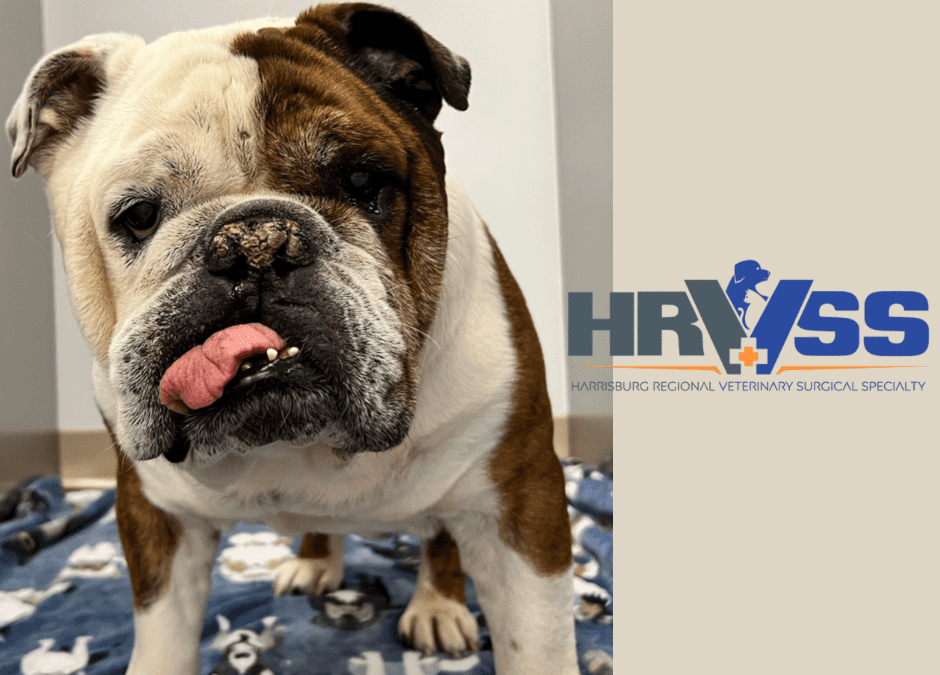“Oscar was miserable, depressed and uncomfortable. He hesitated to go outside to poop…”
Oscar, a 10 year old Olde English Bulldog, had an itchy problem.
And his owner drove 3 hours, all the way from Southern Maryland, to find a solution at Harrisburg Regional.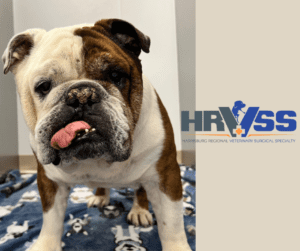 A malformation in Oscar’s tail caused an abnormal skin fold. This condition, which mostly happens in Bulldogs (English or French, as well as Pugs & Boston Terriers), creates a unique environment that is warm, moist and dark.
A malformation in Oscar’s tail caused an abnormal skin fold. This condition, which mostly happens in Bulldogs (English or French, as well as Pugs & Boston Terriers), creates a unique environment that is warm, moist and dark.
This condition can be called a screw tail, corkscrew tail, ingrown tail or tail fold dermatitis.
The convoluted skin fold creates a perfect setting (warm + moist + dark) for bacteria to thrive, which leads to repeated infections.
Antibiotics, wipes and antiseptics can be used, but they are rarely successful at keeping the infection under control long-term.
Repeated infections lead to an itchy, smelly, painful & frustrating situation.
Oscar wasn’t able to turn around to lick the area, so he learned to scoot to relieve the itch. Of course, this doesn’t help any more than when you repeatedly scratch a mosquito bite.
His owner remembers: “Oscar was on several different regimens of antibiotics and creams that didn’t work… His tail issue became worse each week and the smell became more and more offensive. Our family vet did a lot of investigating to find a specialist, and she found you.”
Most clients I talk to about this situation are frustrated after years of failed treatments and mounting veterinary bills.
Yet it’s not the family vet’s fault!
It’s the nature of the condition – the screw tail.
The only definitive solution?
Surgery.
The goal is to remove the end of the tail and the entire infected skin fold surrounding it.
Surgery is fairly technical and can be challenging, so it is often performed by a board-certified surgeon.
There are a few risks to be aware of:
. Bulldogs (brachycephalic breeds, who have a flat face) have a higher risk under anesthesia, so an experienced anesthesia team is important.
. The surgeon will work in a dirty area, because of the tail fold infection.
To make things worse, if you look at Oscar’s picture below, you will see that the anus is very close to the surgery area.
In addition, Oscar had an open wound (aka an ulcer) at the 7 o’clock position. We had to remove it too, which involved reconstructing part of the anus.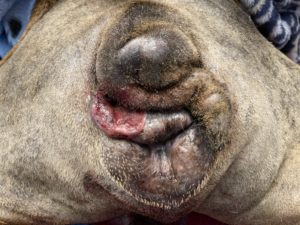 Of course, the skin is scrubbed before surgery, but the risk of infection remains.
Of course, the skin is scrubbed before surgery, but the risk of infection remains.
. There is a happy middle between removing too much skin and not enough. Leaving too much skin means leaving infected tissue behind, which will lead to more infections. Removing too much skin can make stitching up the skin difficult at best.
. Fecal incontinence is often mentioned, but it’s a minor concern in the hands of an experienced surgeon.
. After surgery, some dogs continue to scoot, which can irritate the incision.
Despite the risks, surgery is typically very successful with proper postop care.
The smell disappears instantly.
The itchiness and the scooting should resolve quickly, since there is no reason to itch anymore.
Oscar recovered smoothly after surgery and anesthesia.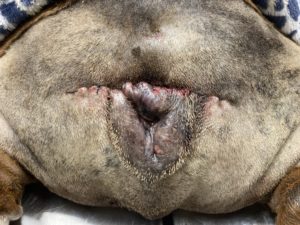 His owner said: “I was so pleased to see Oscar the next day… His behind looked so much better, stitches and all. We didn’t care he lost the rest of his tail if he was comfortable.”
His owner said: “I was so pleased to see Oscar the next day… His behind looked so much better, stitches and all. We didn’t care he lost the rest of his tail if he was comfortable.”
Six weeks after surgery, Oscar’s behind looked much better as you can see below.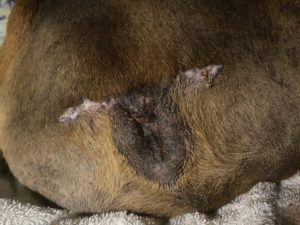 His owner reports:
His owner reports:
“Our experience was wonderful. Oscar has so much more energy now that he has recovered.”
If you would like to learn how we can help your pet with safe surgery and anesthesia, please contact us through www.HRVSS.com
Phil Zeltzman, DVM, DACVS, CVJ, Fear Free Certified
www.HRVSS.com

